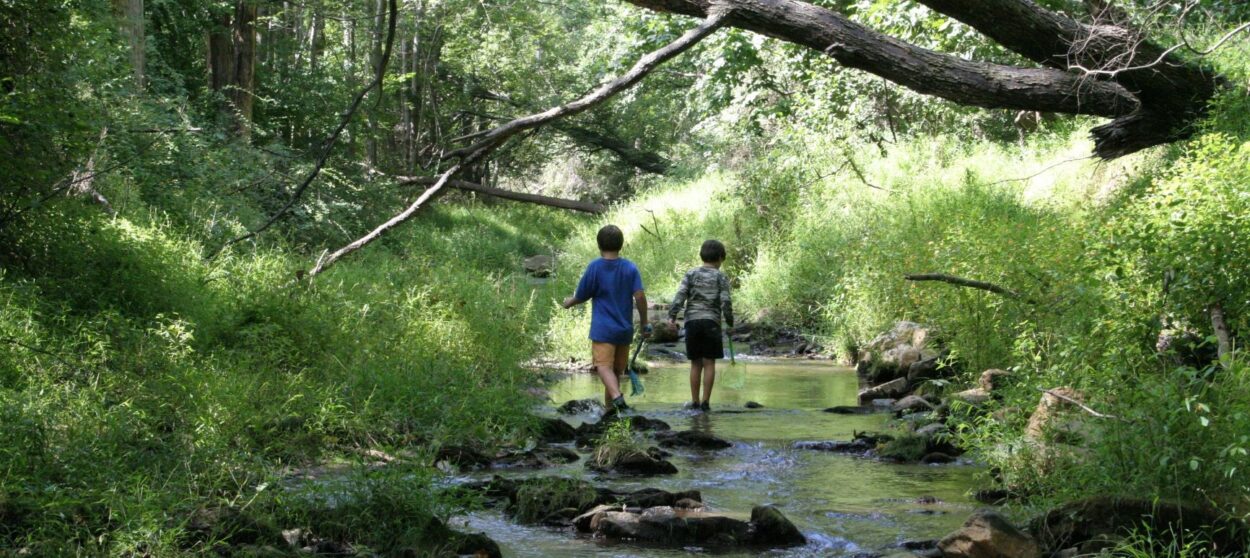“Childhood and Nature: Design Principles for Educators” Fosters Childhood Learning Through Connections with Nature
Playful engagement in nature can be an incredible tool for learning. That’s common sense to many who spent their childhoods climbing trees, watching ants at war, and watching seeds grow into plants. But students in Aimee Arandia Østensen’s course “Childhood and Nature: Design Principles for Educators” also get to learn about the research and best practices that underpin more formal outdoor education. The course, taught for many years now at Antioch University New England, is transformative for many of the student teachers who take it.
Østensen sees the possibility of helping students feel integrated into their wider world as a transformative one. “A meaningful connection to the natural world is a seed,” she says. “It’s the beginning of an adult who takes care of our world in communion with others.”
This transformative power is something that Østensen knows well, as she originally encountered “Childhood and Nature” as a student herself. She was then a student in Antioch’s education program, and David Sobel, who originally designed the course, was still teaching it. She learned firsthand how it helped teachers think about how they might foster a sense of place and community in their future students.
“I fell in love with the course,” Østensen says. “I fell in love with the work, and I immediately applied it to my own teaching practices.”
Østensen is now faculty at Antioch, and she serves as the lead teacher for “Childhood and Nature.” In leading the course, she follows in Sobel’s footsteps while adding some of her own insights to deepen and broaden the material.
The central organizing idea of the course is “play motifs”—which Østensen and Sobel also call “design principles.” For instance: adventure, fantasy and imagination, animal allies, maps and paths, special places, small worlds, and hunting and gathering. These motifs are universal, employed by children worldwide as they play in nature and with each other.
“Childhood and Nature” aims to utilize research and encourage educators to ask how they can design learning to harness their student’s impulses and engagement with their students where they are. “I love it because it’s anchored in research about how children connect to the natural world and explore,” Østensen says.
The course is offered every other summer semester. It is a summer intensive, with most of the work happening during a single week. Østensen describes the schedule during the week as an 8-5 workday, during which student teachers learn the material, test out ideas, and engage with one another. During the week-intensive, Østensen balances the morning and the afternoon hours. Students spend the morning digging into readings and resources through dynamic discussions. During afternoon hours, you can usually find students engaged in hands-on nature play.
 “So one evening, we might focus on the adventure motif, which is predominantly a kinesthetic experience. So we might end up at a swimming hole,” Østensen says. “Or, if it’s the right time of the year, we might climb up a hill to go berry picking. That is really about collecting and foraging.”
“So one evening, we might focus on the adventure motif, which is predominantly a kinesthetic experience. So we might end up at a swimming hole,” Østensen says. “Or, if it’s the right time of the year, we might climb up a hill to go berry picking. That is really about collecting and foraging.”
These trips allow adults to experience nature with a playful mindset, and it’s the perfect way for students to put some of those adult responsibilities aside for a moment. Still, there’s also some serious learning happening during these outings. Students use the knowledge and understanding uncovered from their readings to evaluate how their experience connects to their learning goals. In the end, Østensen wants her class to start thinking about designing experiences for their own students. In addition to the weeklong intensive, students engage in independent work during the pre-intensive and post-intensive periods. The endgame is creating rich and exciting experiences that encourage kids to learn by engaging.
“It’s about designing for engagement with the natural world, but it’s also about knowledge of place and self,” Østensen says. “If you extended it even further, there is the sense of self-sufficiency that develops through free play.”
Although “Childhood and Nature” is most relevant to educators, since the emergence of COVID Østensen has seen a great hunger from her students for programming like this, across the board.
“During COVID, many of us are more likely to be on our screens, and many people talk about feeling languished right now,” Østensen says. “Playing in nature is the antidote to that. The need for the connection to nature is even more palpable now that we’re so much more isolated than we typically are.”
Of course, COVID hasn’t just been a boost to the outdoor learning movement. It’s also changed everything else about our world, including how “Childhood and Nature” is taught. For Summer 2020, Østensen had to figure out how the course would look during a pandemic. “Childhood and Nature” is designed to be a full-body, first-hand experience. Østensen had to figure out how to translate that to an online format. It wasn’t easy, but it worked. In fact, the remote format ended up having some surprising benefits. During the week intensive, people still participated in play challenges, but they did it in their own communities.
“The beautiful part of an online format,” explains Østensen, “is that people are where they live and work. They get to immerse themselves in those places. In some ways, that’s more relevant to what they’re going to be doing.”
It’s hard to say what type of format the course will take in Summer 2022, this next time it will be offered—in a world that hopefully will be post-Covid. Whether online or in-person, “Childhood and Nature: Design Principles for Educators” will continue to be an immersive experience for Antioch students, a key part of their education that explores how to build relationships to place through nature play.






